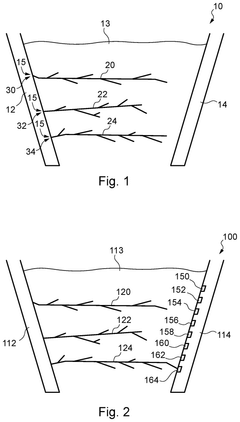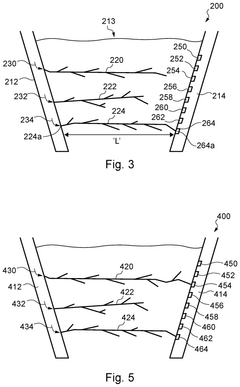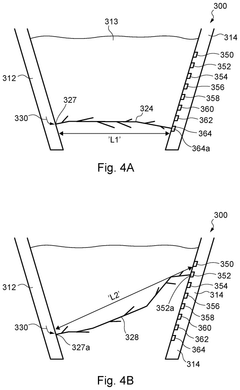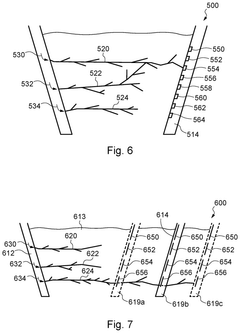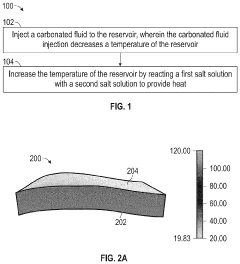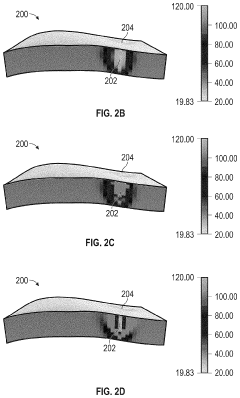How Calorimetry Refines Understanding of Geothermal Reservoirs
AUG 5, 20259 MIN READ
Generate Your Research Report Instantly with AI Agent
Patsnap Eureka helps you evaluate technical feasibility & market potential.
Geothermal Calorimetry Background and Objectives
Geothermal energy has emerged as a promising renewable resource in the global pursuit of sustainable energy solutions. The study of geothermal reservoirs, particularly through calorimetry, has become increasingly crucial in refining our understanding of these complex underground systems. Calorimetry, the science of measuring heat transfer during physical and chemical processes, plays a pivotal role in characterizing geothermal reservoirs and optimizing their exploitation.
The evolution of geothermal technology can be traced back to the early 20th century, with the first geothermal power plant established in Larderello, Italy, in 1904. Since then, advancements in drilling techniques, reservoir engineering, and heat extraction methods have significantly expanded the potential of geothermal energy. However, the accurate assessment and management of geothermal reservoirs remain challenging due to their inherent complexity and heterogeneity.
Calorimetry has emerged as a powerful tool in addressing these challenges. By precisely measuring the heat content and transfer characteristics of geothermal fluids and rock formations, calorimetric techniques provide valuable insights into reservoir behavior, thermal properties, and long-term sustainability. This approach allows for more accurate modeling of reservoir dynamics, leading to improved resource assessment and management strategies.
The primary objectives of applying calorimetry to geothermal reservoirs are multifaceted. Firstly, it aims to enhance the accuracy of reservoir characterization, providing a more detailed understanding of the thermal properties, fluid dynamics, and heat transfer mechanisms within the geothermal system. This improved characterization enables more precise estimation of reservoir capacity and potential energy output.
Secondly, calorimetric studies seek to optimize geothermal energy extraction processes. By quantifying heat flow and thermal conductivity, engineers can design more efficient heat exchange systems and well placement strategies, maximizing energy production while minimizing environmental impact. Additionally, calorimetry aids in predicting long-term reservoir behavior, crucial for sustainable resource management and preventing premature depletion.
Furthermore, the application of calorimetry in geothermal research contributes to the development of advanced reservoir models. These models integrate calorimetric data with other geological and geophysical information, creating more comprehensive and accurate representations of geothermal systems. Such models are invaluable for risk assessment, project planning, and decision-making in geothermal energy development.
As the global demand for clean energy continues to grow, the refinement of geothermal reservoir understanding through calorimetry becomes increasingly significant. This technology not only enhances the efficiency and reliability of existing geothermal operations but also expands the potential for developing new geothermal resources in previously unexplored or underutilized areas.
The evolution of geothermal technology can be traced back to the early 20th century, with the first geothermal power plant established in Larderello, Italy, in 1904. Since then, advancements in drilling techniques, reservoir engineering, and heat extraction methods have significantly expanded the potential of geothermal energy. However, the accurate assessment and management of geothermal reservoirs remain challenging due to their inherent complexity and heterogeneity.
Calorimetry has emerged as a powerful tool in addressing these challenges. By precisely measuring the heat content and transfer characteristics of geothermal fluids and rock formations, calorimetric techniques provide valuable insights into reservoir behavior, thermal properties, and long-term sustainability. This approach allows for more accurate modeling of reservoir dynamics, leading to improved resource assessment and management strategies.
The primary objectives of applying calorimetry to geothermal reservoirs are multifaceted. Firstly, it aims to enhance the accuracy of reservoir characterization, providing a more detailed understanding of the thermal properties, fluid dynamics, and heat transfer mechanisms within the geothermal system. This improved characterization enables more precise estimation of reservoir capacity and potential energy output.
Secondly, calorimetric studies seek to optimize geothermal energy extraction processes. By quantifying heat flow and thermal conductivity, engineers can design more efficient heat exchange systems and well placement strategies, maximizing energy production while minimizing environmental impact. Additionally, calorimetry aids in predicting long-term reservoir behavior, crucial for sustainable resource management and preventing premature depletion.
Furthermore, the application of calorimetry in geothermal research contributes to the development of advanced reservoir models. These models integrate calorimetric data with other geological and geophysical information, creating more comprehensive and accurate representations of geothermal systems. Such models are invaluable for risk assessment, project planning, and decision-making in geothermal energy development.
As the global demand for clean energy continues to grow, the refinement of geothermal reservoir understanding through calorimetry becomes increasingly significant. This technology not only enhances the efficiency and reliability of existing geothermal operations but also expands the potential for developing new geothermal resources in previously unexplored or underutilized areas.
Geothermal Energy Market Analysis
The geothermal energy market has been experiencing significant growth in recent years, driven by increasing demand for clean and sustainable energy sources. As countries worldwide strive to reduce their carbon footprint and transition towards renewable energy, geothermal power has emerged as a reliable and consistent alternative to fossil fuels.
The global geothermal energy market was valued at approximately $5.5 billion in 2020 and is projected to reach $9.4 billion by 2026, growing at a compound annual growth rate (CAGR) of 9.3% during the forecast period. This growth is attributed to several factors, including government initiatives to promote renewable energy, technological advancements in geothermal exploration and drilling techniques, and the increasing awareness of the environmental benefits of geothermal power.
Geographically, the Asia-Pacific region dominates the geothermal energy market, with countries like Indonesia, the Philippines, and New Zealand leading the way in geothermal power generation. North America and Europe also hold significant market shares, with the United States and Iceland being major players in their respective regions.
The market is segmented into various applications, including power generation, direct use, and ground source heat pumps. Power generation remains the largest segment, accounting for over 70% of the total market share. However, direct use applications, such as district heating and industrial processes, are gaining traction due to their high efficiency and lower implementation costs.
Key players in the geothermal energy market include Ormat Technologies, Calpine Corporation, Energy Development Corporation, and Enel Green Power. These companies are actively investing in research and development to improve geothermal technologies and expand their market presence.
Despite the positive growth outlook, the geothermal energy market faces several challenges. High initial capital costs, geological risks associated with exploration and drilling, and the limited availability of suitable geothermal resources in many regions are some of the factors hindering market growth. However, ongoing technological advancements, such as enhanced geothermal systems (EGS) and improved reservoir characterization techniques, are expected to address these challenges and drive further market expansion.
The integration of calorimetry in geothermal reservoir analysis is poised to play a crucial role in refining our understanding of geothermal resources. By providing more accurate measurements of heat flow and thermal properties, calorimetry can significantly improve reservoir characterization and management, leading to more efficient and cost-effective geothermal energy production. This technological advancement is expected to contribute to the overall growth of the geothermal energy market by reducing exploration risks and optimizing resource utilization.
The global geothermal energy market was valued at approximately $5.5 billion in 2020 and is projected to reach $9.4 billion by 2026, growing at a compound annual growth rate (CAGR) of 9.3% during the forecast period. This growth is attributed to several factors, including government initiatives to promote renewable energy, technological advancements in geothermal exploration and drilling techniques, and the increasing awareness of the environmental benefits of geothermal power.
Geographically, the Asia-Pacific region dominates the geothermal energy market, with countries like Indonesia, the Philippines, and New Zealand leading the way in geothermal power generation. North America and Europe also hold significant market shares, with the United States and Iceland being major players in their respective regions.
The market is segmented into various applications, including power generation, direct use, and ground source heat pumps. Power generation remains the largest segment, accounting for over 70% of the total market share. However, direct use applications, such as district heating and industrial processes, are gaining traction due to their high efficiency and lower implementation costs.
Key players in the geothermal energy market include Ormat Technologies, Calpine Corporation, Energy Development Corporation, and Enel Green Power. These companies are actively investing in research and development to improve geothermal technologies and expand their market presence.
Despite the positive growth outlook, the geothermal energy market faces several challenges. High initial capital costs, geological risks associated with exploration and drilling, and the limited availability of suitable geothermal resources in many regions are some of the factors hindering market growth. However, ongoing technological advancements, such as enhanced geothermal systems (EGS) and improved reservoir characterization techniques, are expected to address these challenges and drive further market expansion.
The integration of calorimetry in geothermal reservoir analysis is poised to play a crucial role in refining our understanding of geothermal resources. By providing more accurate measurements of heat flow and thermal properties, calorimetry can significantly improve reservoir characterization and management, leading to more efficient and cost-effective geothermal energy production. This technological advancement is expected to contribute to the overall growth of the geothermal energy market by reducing exploration risks and optimizing resource utilization.
Calorimetry Challenges in Geothermal Exploration
Calorimetry, a fundamental technique in thermal analysis, faces significant challenges when applied to geothermal exploration. The complex nature of geothermal reservoirs, characterized by high temperatures, pressures, and diverse mineral compositions, presents unique obstacles for accurate calorimetric measurements.
One of the primary challenges is the need for specialized equipment capable of withstanding extreme conditions. Traditional calorimeters are often inadequate for the high-temperature and high-pressure environments encountered in geothermal systems. Developing robust, field-deployable calorimeters that can operate reliably under these conditions remains an ongoing technical hurdle.
Sample preparation and handling pose another set of difficulties. Geothermal fluids and rock samples can be highly reactive and corrosive, potentially compromising the integrity of measurement apparatus and leading to inaccurate results. Ensuring proper isolation and containment of samples without altering their thermal properties is crucial for obtaining reliable data.
The heterogeneity of geothermal reservoirs further complicates calorimetric analysis. Variations in mineral composition, porosity, and fluid content across relatively small spatial scales can lead to significant discrepancies in thermal properties. This heterogeneity necessitates careful sampling strategies and multiple measurements to obtain representative data for the entire reservoir.
Temporal variations in geothermal systems present additional challenges. The dynamic nature of these reservoirs, influenced by factors such as fluid circulation and tectonic activity, means that thermal properties can change over time. Capturing these temporal variations through calorimetry requires long-term monitoring and repeated measurements, which can be logistically challenging and resource-intensive.
Interpreting calorimetric data in the context of geothermal systems is also complex. The interplay between various heat transfer mechanisms, including conduction, convection, and phase changes, makes it difficult to isolate and quantify individual thermal processes. Developing sophisticated models that can accurately interpret calorimetric data in the context of these complex systems is an ongoing area of research.
Furthermore, scaling laboratory measurements to reservoir-scale predictions introduces additional uncertainties. The vast differences in scale between laboratory samples and actual geothermal reservoirs necessitate careful extrapolation and validation of calorimetric data. Bridging this gap between micro-scale measurements and macro-scale reservoir behavior remains a significant challenge in geothermal exploration.
One of the primary challenges is the need for specialized equipment capable of withstanding extreme conditions. Traditional calorimeters are often inadequate for the high-temperature and high-pressure environments encountered in geothermal systems. Developing robust, field-deployable calorimeters that can operate reliably under these conditions remains an ongoing technical hurdle.
Sample preparation and handling pose another set of difficulties. Geothermal fluids and rock samples can be highly reactive and corrosive, potentially compromising the integrity of measurement apparatus and leading to inaccurate results. Ensuring proper isolation and containment of samples without altering their thermal properties is crucial for obtaining reliable data.
The heterogeneity of geothermal reservoirs further complicates calorimetric analysis. Variations in mineral composition, porosity, and fluid content across relatively small spatial scales can lead to significant discrepancies in thermal properties. This heterogeneity necessitates careful sampling strategies and multiple measurements to obtain representative data for the entire reservoir.
Temporal variations in geothermal systems present additional challenges. The dynamic nature of these reservoirs, influenced by factors such as fluid circulation and tectonic activity, means that thermal properties can change over time. Capturing these temporal variations through calorimetry requires long-term monitoring and repeated measurements, which can be logistically challenging and resource-intensive.
Interpreting calorimetric data in the context of geothermal systems is also complex. The interplay between various heat transfer mechanisms, including conduction, convection, and phase changes, makes it difficult to isolate and quantify individual thermal processes. Developing sophisticated models that can accurately interpret calorimetric data in the context of these complex systems is an ongoing area of research.
Furthermore, scaling laboratory measurements to reservoir-scale predictions introduces additional uncertainties. The vast differences in scale between laboratory samples and actual geothermal reservoirs necessitate careful extrapolation and validation of calorimetric data. Bridging this gap between micro-scale measurements and macro-scale reservoir behavior remains a significant challenge in geothermal exploration.
Current Calorimetric Methods for Geothermal Reservoirs
01 Calorimetry measurement techniques
Various techniques are employed in calorimetry to measure heat transfer and energy changes in chemical or physical processes. These methods may include differential scanning calorimetry, isothermal titration calorimetry, and bomb calorimetry. Advanced sensors and precise temperature control systems are utilized to ensure accurate measurements of heat flow and thermal properties.- Calorimetry measurement techniques: Various techniques are employed in calorimetry to measure heat transfer and energy changes in chemical or physical processes. These methods include differential scanning calorimetry, isothermal titration calorimetry, and bomb calorimetry. Advanced sensors and precise temperature control systems are utilized to ensure accurate measurements of heat flow and thermal properties.
- Data analysis and interpretation in calorimetry: Sophisticated algorithms and software tools are developed to analyze and interpret calorimetric data. These systems can process complex thermodynamic information, identify patterns, and generate meaningful results from raw calorimetric measurements. Machine learning and artificial intelligence techniques are increasingly applied to enhance data analysis capabilities and extract valuable insights from calorimetric experiments.
- Applications of calorimetry in various fields: Calorimetry finds applications in diverse fields such as materials science, pharmaceuticals, food industry, and biochemistry. It is used for studying phase transitions, determining binding affinities of biomolecules, assessing food quality, and characterizing the thermal properties of materials. The versatility of calorimetric techniques makes them valuable tools in research and development across multiple disciplines.
- Miniaturization and portability of calorimetric devices: Efforts are being made to develop miniaturized and portable calorimetric devices for on-site measurements and point-of-care diagnostics. These compact systems integrate advanced sensing technologies and microfluidics to enable rapid and accurate calorimetric analysis in field conditions. The miniaturization trend aims to expand the accessibility and applicability of calorimetry in various settings.
- Integration of calorimetry with other analytical techniques: Calorimetry is increasingly being integrated with other analytical techniques to provide comprehensive characterization of materials and processes. Combining calorimetry with spectroscopy, chromatography, or microscopy enables simultaneous measurement of thermal properties along with structural, chemical, or morphological information. This integration enhances the depth and breadth of analytical capabilities in research and industrial applications.
02 Data analysis and interpretation in calorimetry
Sophisticated algorithms and software tools are developed to analyze and interpret calorimetric data. These systems can process large datasets, identify patterns, and extract meaningful information from complex thermal profiles. Machine learning and artificial intelligence techniques may be applied to enhance data interpretation and predictive capabilities in calorimetric studies.Expand Specific Solutions03 Applications of calorimetry in biological systems
Calorimetry plays a crucial role in understanding biological processes and interactions. It is used to study protein folding, enzyme kinetics, and drug-target interactions. Specialized calorimeters are designed to accommodate living cells and tissues, enabling real-time monitoring of metabolic activities and cellular responses to various stimuli.Expand Specific Solutions04 Integration of calorimetry with other analytical techniques
Calorimetry is often combined with other analytical methods to provide comprehensive characterization of materials and processes. This integration may involve spectroscopic techniques, chromatography, or microscopy. Such hybrid approaches enhance the understanding of thermal events by correlating them with structural, chemical, or morphological changes in the sample.Expand Specific Solutions05 Advancements in calorimeter design and miniaturization
Ongoing research focuses on improving calorimeter design for enhanced sensitivity and versatility. Miniaturization efforts aim to develop microfluidic calorimetry devices for high-throughput screening and point-of-care diagnostics. These advancements enable the study of smaller sample volumes and faster thermal equilibration, expanding the applicability of calorimetry across various fields.Expand Specific Solutions
Key Players in Geothermal Calorimetry Research
The geothermal reservoir understanding through calorimetry is in a developing stage, with the market showing significant growth potential. The technology's maturity varies across companies, with established players like Schlumberger, Saudi Aramco, and PetroChina leading research efforts. Emerging firms such as Resman AS are also contributing innovations. The competitive landscape is diverse, including major oil and gas corporations, specialized geothermal companies, and research institutions like ETH Zurich and the Chinese Academy of Sciences. This mix of participants indicates a growing interest in refining geothermal reservoir characterization techniques, driven by the increasing demand for renewable energy sources and the need for more efficient resource management in the geothermal sector.
Schlumberger Technologies, Inc.
Technical Solution: Schlumberger has developed advanced calorimetry techniques for geothermal reservoir characterization. Their approach combines high-precision temperature measurements with innovative heat flow modeling to provide detailed insights into reservoir properties. The company utilizes distributed temperature sensing (DTS) technology to obtain continuous temperature profiles along wellbores, allowing for real-time monitoring of heat distribution[1]. Additionally, Schlumberger has implemented machine learning algorithms to analyze calorimetric data, enabling more accurate predictions of reservoir behavior and potential[2]. Their system integrates data from multiple sources, including seismic surveys and well logs, to create comprehensive 3D thermal models of geothermal reservoirs[3].
Strengths: Comprehensive integration of multiple data sources, real-time monitoring capabilities, and advanced machine learning analytics. Weaknesses: High implementation costs and potential complexity in data interpretation for less experienced operators.
Saudi Arabian Oil Co.
Technical Solution: Saudi Aramco has developed a novel calorimetry-based approach for geothermal reservoir assessment, focusing on dual-purpose wells that can produce both geothermal energy and hydrocarbons. Their technology utilizes high-temperature resistant fiber optic sensors for distributed temperature sensing (DTS) and distributed acoustic sensing (DAS) to provide real-time, high-resolution temperature and acoustic data throughout the wellbore[4]. This allows for precise mapping of heat flow and fluid movement within the reservoir. Aramco's system also incorporates advanced thermal conductivity measurements of rock samples to enhance the accuracy of heat flow models. The company has implemented machine learning algorithms to analyze the vast amounts of data generated, enabling more accurate predictions of reservoir performance and longevity[5].
Strengths: Dual-purpose well technology, high-resolution real-time data acquisition, and advanced data analytics. Weaknesses: Limited experience in pure geothermal applications and potential challenges in adapting the technology to non-hydrocarbon reservoirs.
Innovative Calorimetry Technologies for Geothermal Applications
System and method of monitoring fracturing in geothermal systems
PatentPendingUS20250179911A1
Innovation
- A method involving the use of tracer sources with distinct materials in production wells, injecting tracers into fractures in injection wells, and analyzing produced fluid samples to estimate fracture characteristics such as permeability, volume, and surface area.
Thermochemical fluid injection to prevent cool front invasion in CO<sub>2 </sub>geothermal reservoirs
PatentActiveUS12006794B1
Innovation
- A method and system involving the injection of a carbonated fluid, a first salt solution, and a second salt solution into a geothermal reservoir, where the second salt solution reacts with the first salt solution to generate heat, controlling the reservoir temperature and preventing cold front invasion, thereby enhancing heat transfer and energy efficiency.
Environmental Impact of Geothermal Exploration
Geothermal exploration, while offering a promising source of renewable energy, carries potential environmental impacts that must be carefully considered and mitigated. The process of exploring and developing geothermal reservoirs can affect various aspects of the surrounding ecosystem, including land use, water resources, air quality, and local biodiversity.
One of the primary environmental concerns associated with geothermal exploration is land disturbance. The construction of drilling pads, access roads, and other infrastructure can lead to habitat fragmentation and soil erosion. This is particularly significant in sensitive ecosystems or areas of high biodiversity. Careful site selection and minimally invasive exploration techniques can help reduce these impacts.
Water resources are another critical consideration in geothermal exploration. The drilling process and subsequent reservoir testing often require substantial amounts of water, which can strain local water supplies, especially in arid regions. Additionally, there is a risk of groundwater contamination from drilling fluids or geothermal brine if proper safeguards are not in place. Implementing closed-loop systems and robust wastewater management practices can mitigate these risks.
Air quality can be affected during geothermal exploration, primarily through the release of non-condensable gases such as carbon dioxide, hydrogen sulfide, and methane. While these emissions are generally lower than those from fossil fuel-based energy sources, they still require monitoring and control measures to minimize their impact on local air quality and contribute to greenhouse gas reduction goals.
Noise pollution is another environmental concern, particularly during the drilling and testing phases of geothermal exploration. The continuous operation of drilling rigs and other equipment can disrupt local wildlife and nearby human communities. Implementing noise reduction technologies and scheduling work to minimize disturbance during sensitive periods can help address this issue.
The potential for induced seismicity is a growing concern in geothermal exploration. While most geothermal activities do not cause significant seismic events, some enhanced geothermal system (EGS) projects have been associated with induced earthquakes. Careful site selection, continuous monitoring, and adaptive management strategies are essential to minimize this risk.
Visual impacts on the landscape should also be considered, especially in areas of natural beauty or cultural significance. The presence of drilling rigs, power plants, and transmission lines can alter the visual character of an area. Thoughtful design and siting of facilities, along with landscape restoration efforts, can help mitigate these visual impacts.
In conclusion, while geothermal exploration offers significant potential for clean energy production, it is crucial to address its environmental impacts through comprehensive planning, advanced technologies, and stringent regulatory frameworks. By doing so, the geothermal industry can maximize its benefits while minimizing its ecological footprint.
One of the primary environmental concerns associated with geothermal exploration is land disturbance. The construction of drilling pads, access roads, and other infrastructure can lead to habitat fragmentation and soil erosion. This is particularly significant in sensitive ecosystems or areas of high biodiversity. Careful site selection and minimally invasive exploration techniques can help reduce these impacts.
Water resources are another critical consideration in geothermal exploration. The drilling process and subsequent reservoir testing often require substantial amounts of water, which can strain local water supplies, especially in arid regions. Additionally, there is a risk of groundwater contamination from drilling fluids or geothermal brine if proper safeguards are not in place. Implementing closed-loop systems and robust wastewater management practices can mitigate these risks.
Air quality can be affected during geothermal exploration, primarily through the release of non-condensable gases such as carbon dioxide, hydrogen sulfide, and methane. While these emissions are generally lower than those from fossil fuel-based energy sources, they still require monitoring and control measures to minimize their impact on local air quality and contribute to greenhouse gas reduction goals.
Noise pollution is another environmental concern, particularly during the drilling and testing phases of geothermal exploration. The continuous operation of drilling rigs and other equipment can disrupt local wildlife and nearby human communities. Implementing noise reduction technologies and scheduling work to minimize disturbance during sensitive periods can help address this issue.
The potential for induced seismicity is a growing concern in geothermal exploration. While most geothermal activities do not cause significant seismic events, some enhanced geothermal system (EGS) projects have been associated with induced earthquakes. Careful site selection, continuous monitoring, and adaptive management strategies are essential to minimize this risk.
Visual impacts on the landscape should also be considered, especially in areas of natural beauty or cultural significance. The presence of drilling rigs, power plants, and transmission lines can alter the visual character of an area. Thoughtful design and siting of facilities, along with landscape restoration efforts, can help mitigate these visual impacts.
In conclusion, while geothermal exploration offers significant potential for clean energy production, it is crucial to address its environmental impacts through comprehensive planning, advanced technologies, and stringent regulatory frameworks. By doing so, the geothermal industry can maximize its benefits while minimizing its ecological footprint.
Economic Viability of Calorimetry-Based Geothermal Projects
The economic viability of calorimetry-based geothermal projects hinges on several key factors that must be carefully evaluated. Calorimetry, as a method for refining our understanding of geothermal reservoirs, offers potential benefits that could significantly impact project economics.
One of the primary advantages of calorimetry in geothermal exploration is its ability to provide more accurate assessments of reservoir characteristics. This improved accuracy can lead to better-informed decision-making during the project planning phase, potentially reducing the risk of costly drilling failures and improving overall project success rates.
The implementation of calorimetry techniques in geothermal projects may require additional upfront investment in specialized equipment and expertise. However, this initial cost could be offset by the long-term benefits of more efficient resource utilization and improved plant performance.
Calorimetry-based assessments can help optimize the design and operation of geothermal power plants. By providing a more detailed understanding of reservoir thermodynamics, engineers can fine-tune power generation systems to maximize energy extraction and conversion efficiency. This optimization can lead to increased power output and improved plant economics over the project lifecycle.
The economic impact of calorimetry extends beyond initial resource assessment and plant design. Ongoing monitoring using calorimetric techniques can help maintain optimal performance by detecting changes in reservoir conditions early. This proactive approach to reservoir management can extend the productive life of geothermal fields and enhance long-term project viability.
From a market perspective, the adoption of advanced calorimetry methods could potentially unlock previously marginal geothermal resources. By improving the accuracy of resource assessments, projects that were once considered economically unfeasible may become viable, expanding the overall market for geothermal energy.
Investors and financial institutions may view calorimetry-based geothermal projects more favorably due to the reduced uncertainty and improved risk profile. This could lead to better financing terms and increased investment in the geothermal sector, further driving down costs and improving economic viability.
However, the economic benefits of calorimetry must be weighed against the costs of implementation and the specific characteristics of each geothermal project. Factors such as local energy prices, regulatory environments, and competing energy sources will all play a role in determining the ultimate economic viability of calorimetry-based geothermal projects.
One of the primary advantages of calorimetry in geothermal exploration is its ability to provide more accurate assessments of reservoir characteristics. This improved accuracy can lead to better-informed decision-making during the project planning phase, potentially reducing the risk of costly drilling failures and improving overall project success rates.
The implementation of calorimetry techniques in geothermal projects may require additional upfront investment in specialized equipment and expertise. However, this initial cost could be offset by the long-term benefits of more efficient resource utilization and improved plant performance.
Calorimetry-based assessments can help optimize the design and operation of geothermal power plants. By providing a more detailed understanding of reservoir thermodynamics, engineers can fine-tune power generation systems to maximize energy extraction and conversion efficiency. This optimization can lead to increased power output and improved plant economics over the project lifecycle.
The economic impact of calorimetry extends beyond initial resource assessment and plant design. Ongoing monitoring using calorimetric techniques can help maintain optimal performance by detecting changes in reservoir conditions early. This proactive approach to reservoir management can extend the productive life of geothermal fields and enhance long-term project viability.
From a market perspective, the adoption of advanced calorimetry methods could potentially unlock previously marginal geothermal resources. By improving the accuracy of resource assessments, projects that were once considered economically unfeasible may become viable, expanding the overall market for geothermal energy.
Investors and financial institutions may view calorimetry-based geothermal projects more favorably due to the reduced uncertainty and improved risk profile. This could lead to better financing terms and increased investment in the geothermal sector, further driving down costs and improving economic viability.
However, the economic benefits of calorimetry must be weighed against the costs of implementation and the specific characteristics of each geothermal project. Factors such as local energy prices, regulatory environments, and competing energy sources will all play a role in determining the ultimate economic viability of calorimetry-based geothermal projects.
Unlock deeper insights with Patsnap Eureka Quick Research — get a full tech report to explore trends and direct your research. Try now!
Generate Your Research Report Instantly with AI Agent
Supercharge your innovation with Patsnap Eureka AI Agent Platform!
